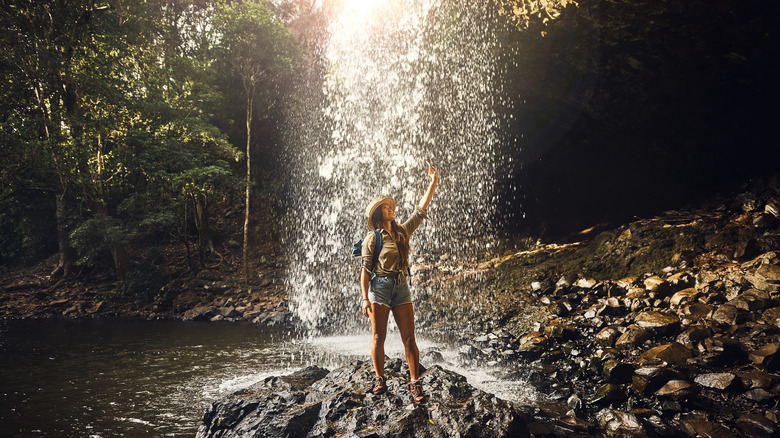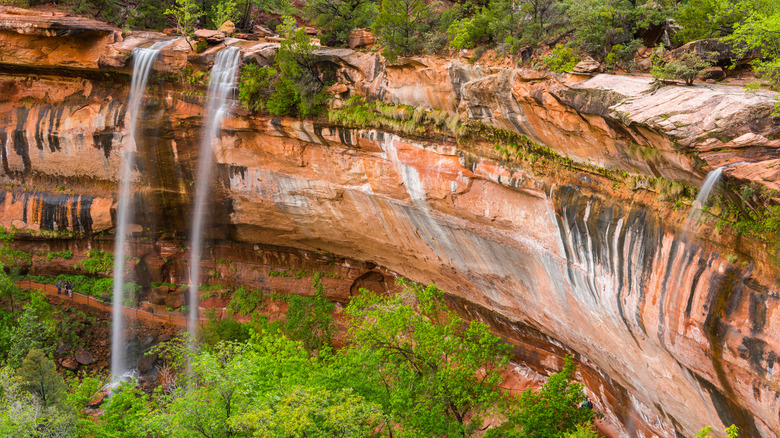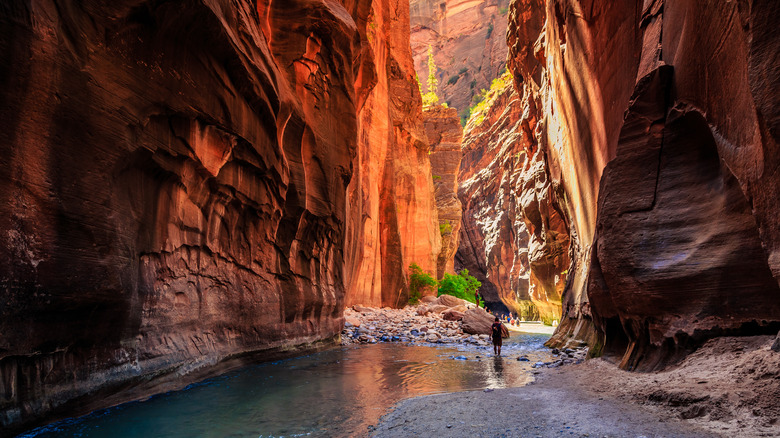Hike To Beautiful Waterfalls And Emerald Pools At This Popular National Park
Located in the gorgeous southwestern United States and one of Utah's Mighty Five, Zion National Park is renowned for its unique geography and diverse hiking opportunities. It covers an area of 148,733 acres and is characterized by its striking red rock formations, deep canyons, and amazing waterfalls. The park is situated at the intersection of the Great Basin, the Colorado Plateau, and the Mojave Desert, creating a remarkable mix of ecosystems and landscapes, including some stunning emerald pools.
To reach Zion National Park, Springdale, Utah, is the gateway. Springdale has an array of lodging options for Zion visitors, all within minutes of the park's main entrance, but if you're looking for a closer stay, the Zion Lodge is located in the park. Whether staying inside the park or driving in from Springdale, Zion offers a wide variety of hiking for all skill levels.
The park's shuttle service operates seasonally, taking visitors from the visitor center through Zion Canyon Scenic Drive. Access to the Emerald Pools trail, among other waterfall hikes, is only available by shuttle during the park's busier months. Still, in the eastern section, Zion's Scenic Byway is available to vehicles year-round. During the winter, when the shuttle isn't running, visitors can access Zion Canyon in their own vehicles, so planning a winter trip to Zion or hiking along the byway is the best option if you're not interested in riding the shuttle. Be mindful, though, that some trails and falls are closed in the winter season.
Zion's stunning emerald pools
No matter the season, the Emerald Pools Trail is one of the most popular hikes in Zion. The trailhead can be conveniently accessed from the Zion Lodge, making it a great option for first-time visitors staying in the park. The trail is divided into three parts: the Lower, Middle, and Upper Emerald Pools. Each section offers a unique perspective and a different level of difficulty.
The Lower Emerald Pool is the easiest section of the trail, making it accessible to hikers of all levels. After a brief half-mile hike, you'll find yourself standing in front of a stunning alcove behind a 110-foot waterfall falling into the lower pool. Visitors can continue to the upper pools from the waterfall or take the path back for an almost 1.5-mile round-trip hike. In case of bridge or path closures, this trail can be accessed via the Kayenta trail.
The Middle Emerald Pool, located just above the Lower Pool, offers a more challenging 2.2-mile hike. After being closed for nearly a decade, the trail opened again to visitors in 2020. The newly reinforced course becomes steeper and narrower following a ledge above the lower trail, so depending on how well you handle heights, take it with caution or turn back to follow the lower pathway. To get to the Upper Emerald Pool, it is another additional 1-mile trail with even rougher terrain. High cliffs surround the Upper Emerald Pool, and a tall waterfall feeds the upper pool.
Experience Zion's other waterfall trails
In addition to the mesmerizing emerald pools and their falls, Zion National Park is known for many other impressive cascades around the park. Take the Zion shuttle to Stop 9 – the Temple of Sinawava stop – to explore the 2-mile round-trip Riverside Walk leading to the Virgin River, home to Mystery Falls. From the end of the Riverside Walk, you'll venture an additional half-mile wading through the (typically) shallow river to get to the 120-foot Mystery Falls. This hike is one of the best reasons to visit Zion.
Continue along the course of the river to make it to the alcoves and the hike's famous Wall Street section, but during the winter and early spring, water levels in the river rise, often leading to a temporary closure of the area. Opt for a summer trip for the best chance to see each site of the hike. Some of Zion's more difficult waterfall trails aren't as accessible for the everyday hiker. Archangel Falls in the park's lesser-visited Kolob Terrace section includes a 9-mile hike that requires canyoneering and rappelling skills.
One of the most accessible waterfalls can be found along the 0.4-mile Weeping Rock Trail. The Weeping Rock Trail is a short, paved path near Stop 7 on the shuttle route. It leads to an alcove where water seeps from the rocks above. The fall is most active in the spring and fall and can be closed due to ice in the winter.


